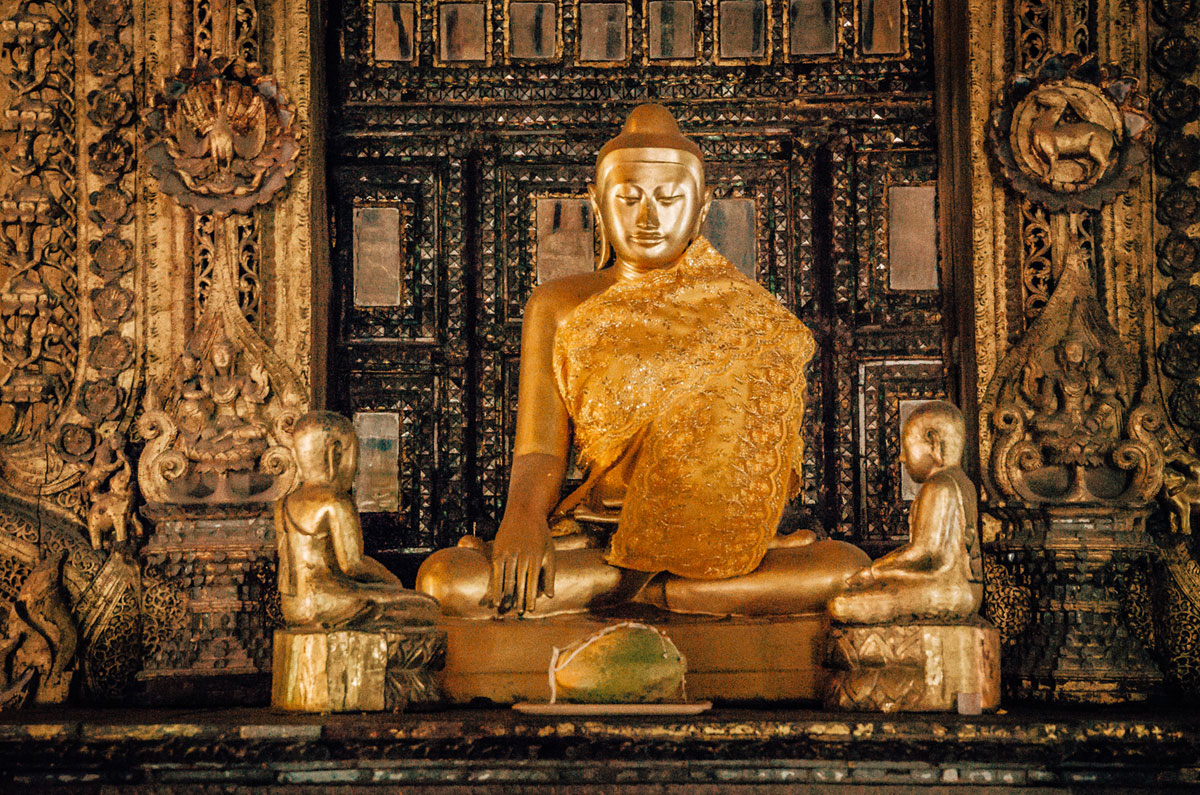Overview
Since I was child, I thought of Mandalay as an exotic city, even though I did not know anything about it. Before I finally visited it, I expected it had centuries-old-housing stock and ancient ruins, similar to Kathmandu. When I finally arrived on this journey, I had the same surprise as when I went to Casablanca and discovered that almost all of the buildings were constructed in the twentieth century.
Surrounded by ancient capitals, Mandalay was built in only 1857 when the Konbaung dynasty (1752 to 1885, the last one before total British subjugation) relocated the capital from nearby Amarapura (now a township of Mandalay which has enlarged over the years). An expansionist dynasty, the Konbaung kings invaded Manipur and Assam (now Indian states), Arakan (now the Myanmar state of Rakhine), the Mon kingdom of Pegu (now the Bago region of Myanmar, northeast of Yangon) and the Siamese kingdom of Ayutthaya (now a region north of Bangkok in Thailand). The current borders of Myanmar are a result of treaties stemming from territorial expansions and retreats of this dynasty.
The Konbaung kings moved the capital seven time, twice to a former one. Each move deconstructed buildings and used elephants to move the wood and masonry for the construction in the new location. The move to Mandalay was done for a number of reasons including:
- King Mindon wanted to demonstrate his legitimacy after dethroning his brother in a coup d’etat.
- the site was militarily more secure as it was not close to a river, like Amarapura, which could be a huge help to invaders (interestingly, some knowledgeable observers feel this is the primary reason the capital was recently changed from Yangon to Naypyidaw),
- the move was part of the modernization of the country by instituting a grid street system and facilitating administrative reforms, and
- the new capital was planned to be a Buddhist metropolis, as it was where purportedly Buddha foretold prosperity when he visited this location, which brought political support from the Buddhist priests and others.
The city looks like it was mostly constructed in the 1950s and 1960s. This is unsurprising as it was almost completely destroyed by devastating air raids in WWII. However, this is not a generic metropolis, but the cultural and educational center of the country. It has a remarkable collection of Buddhist structures, artifacts and art pieces. As the second biggest city in the country (population around 1.3 million), it is bustling economically, boosted by a relatively recent influx of Chinese business people, mostly from the Yunnan province. Mandalay is a booming destination with much to be explored.
This is Part 7 (of 8) of our adventure to Myanmar. The four of us (Peter, Caitlin, Khadija and me) found everywhere we went in the country endlessly interesting. For an overview of Myanmar, see https://exploringed.com/myanmar-part-1-overview-yangon/
U Bein Bridge
U Bein is the largest and oldest teak wood bridge in the world, built around 1850 in Amarapura, then the capital. The narrow walking bridge stretches and curves 1.2 km (.75 miles) across Taungthaman Lake. It is used extensively by locals and souvenir vendors. It is named after the mayor at the time of construction. Some of the teak came from the old palace in Inwa, another former capital. Reusing valuable building components has been a tradition in this region over the centuries.
We took a taxi from our hotel before sunrise. When we arrived, the water was far below the bridge (in the wet season, it can reach the bridge).
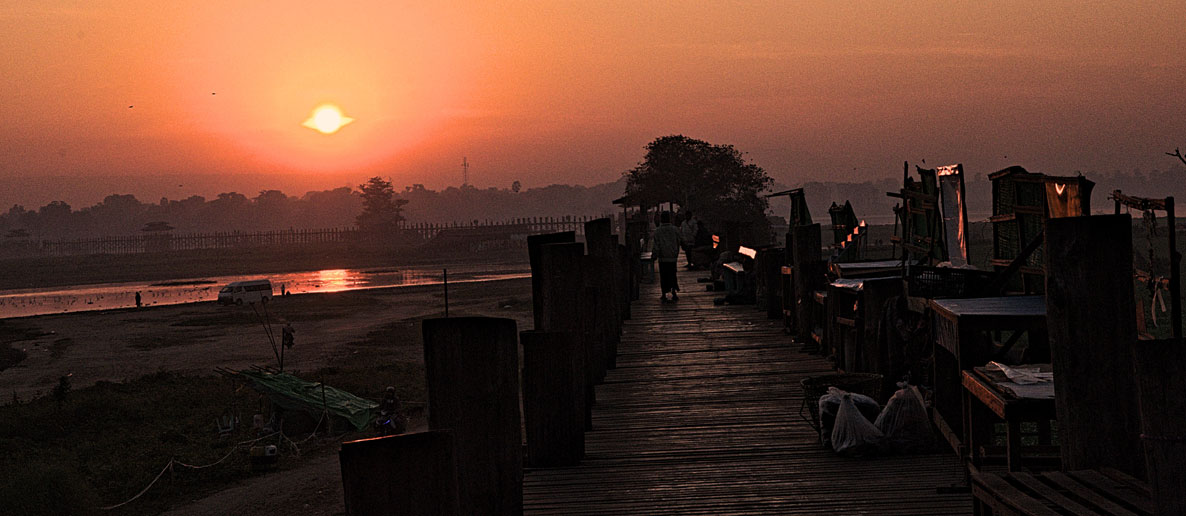
It was fantastic watching fisherman walk through the water using huge nets in front of the red sky and rising-sun landscape.
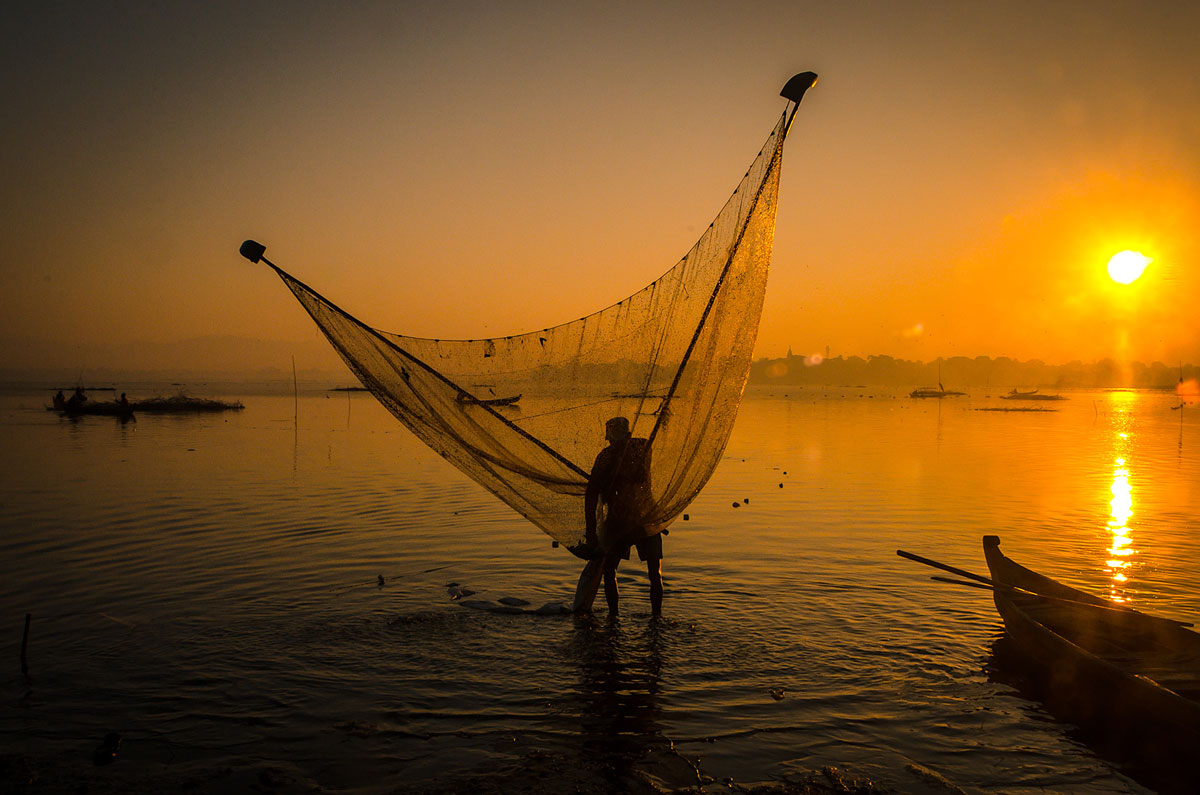
We liked seeing locals walking by the beach or opening shops in the warm, soft light.

While we felt it was warm, the locals bundled up as it is the coldest part of the year for them (which it is).
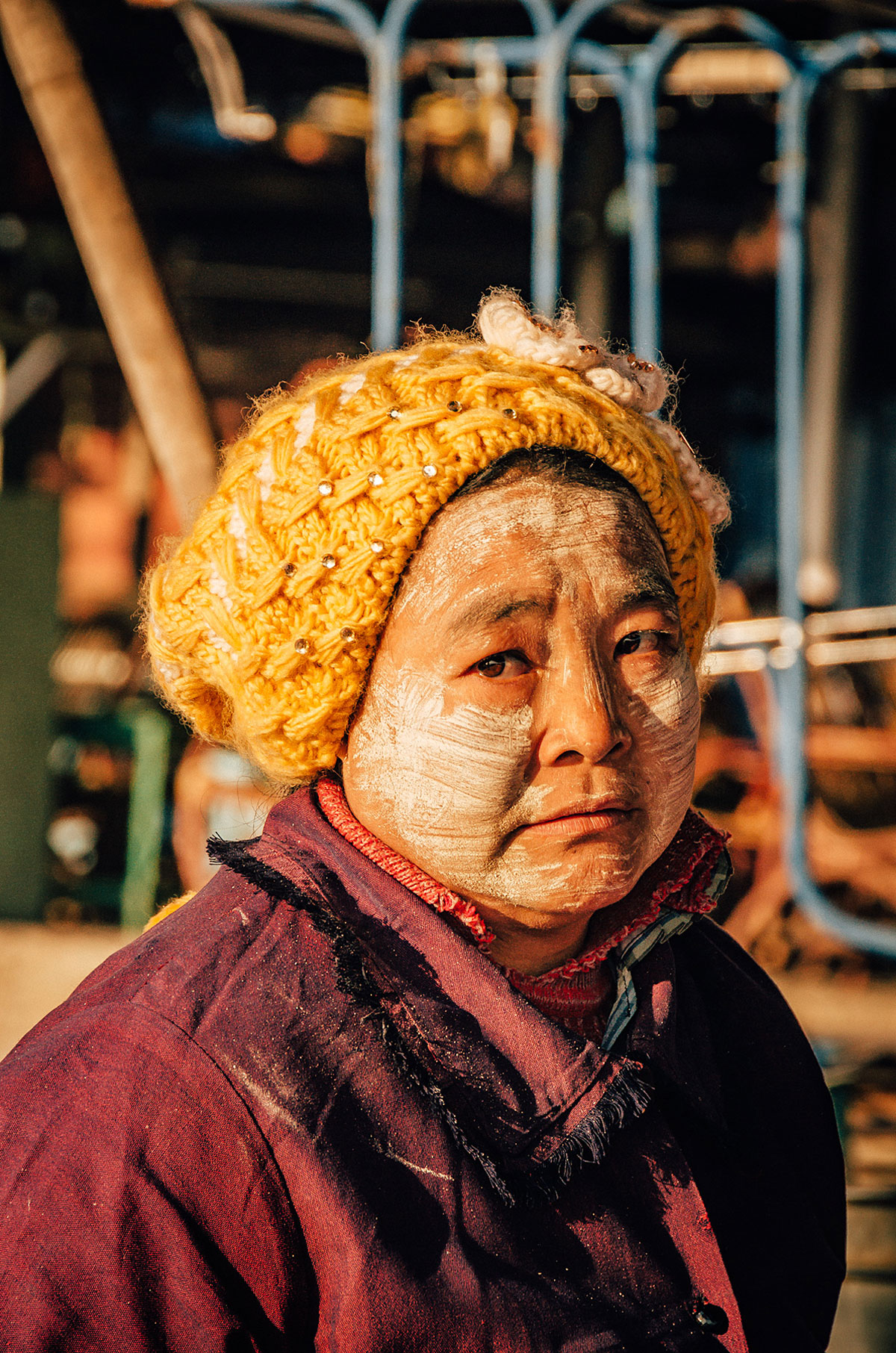
Of particular interest, we saw a huge stupa across the lake.

The area had many Buddhist priests sashaying around, as well as monasteries, temples and other Buddhist structures. We had limited time in Mandalay, so we did not visit any but focused on the locals, such as a fisherman taking a smoke break on the shore.

I read going at sunset can be too full of tourists, which was not the case in the morning, though the numbers steadily grew as the day progressed.
Mandalay Palace
We went to the Mandalay Palace in the heart of the city, situated on perfectly square and massive grounds, bigger than Central Park in Manhattan. It is surrounded by four walls (2 kilometers / 1.2 miles each) and a moat. Although much of the original palace was destroyed by allied bombing in 1945, there is an original watchtower and much of the rest has been faithfully restored.
We bought our tickets for multiple archeological sites in Mandalay, including this one, for K10,000/person (about $7.50) and valid for a week. This was a much better deal than paying individual admissions, usually for half this amount. To buy, we had to show our passports. In the Mandalay Palace, we were allowed to see the historical sites of interest to visitors but could not wander in the rest of the complex where the military had barracks and equipment.
The payment booth is just outside an interior wall which has a chilling inscription: “The Tatmadaw and the people crush all those harming the union”. The military’s official name is Tatmadaw.
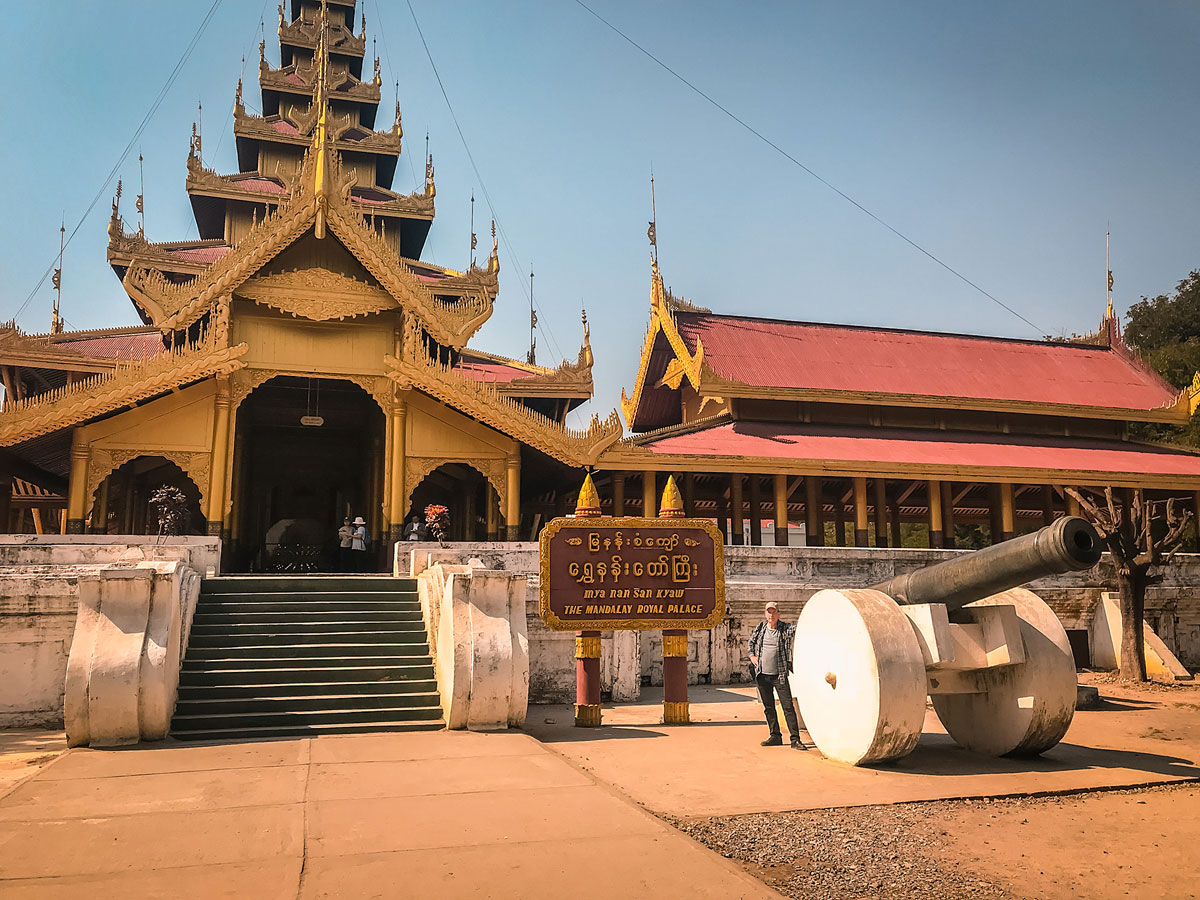
There is the entrance through this interior wall to the first of many buildings of the royal family.
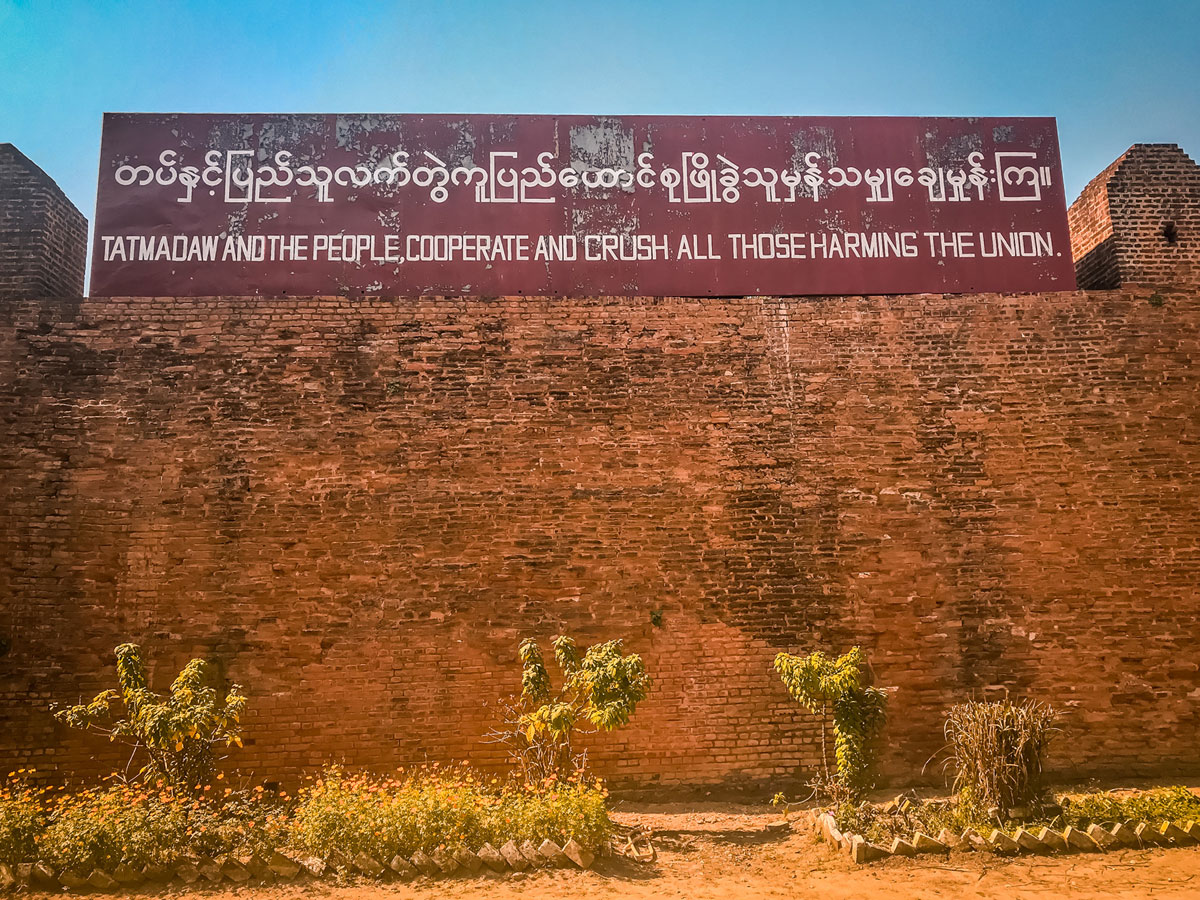
As we went from building to building, we were impressed by the intricate wall carvings on the exterior, as shown behind Caitlin and Khadija.
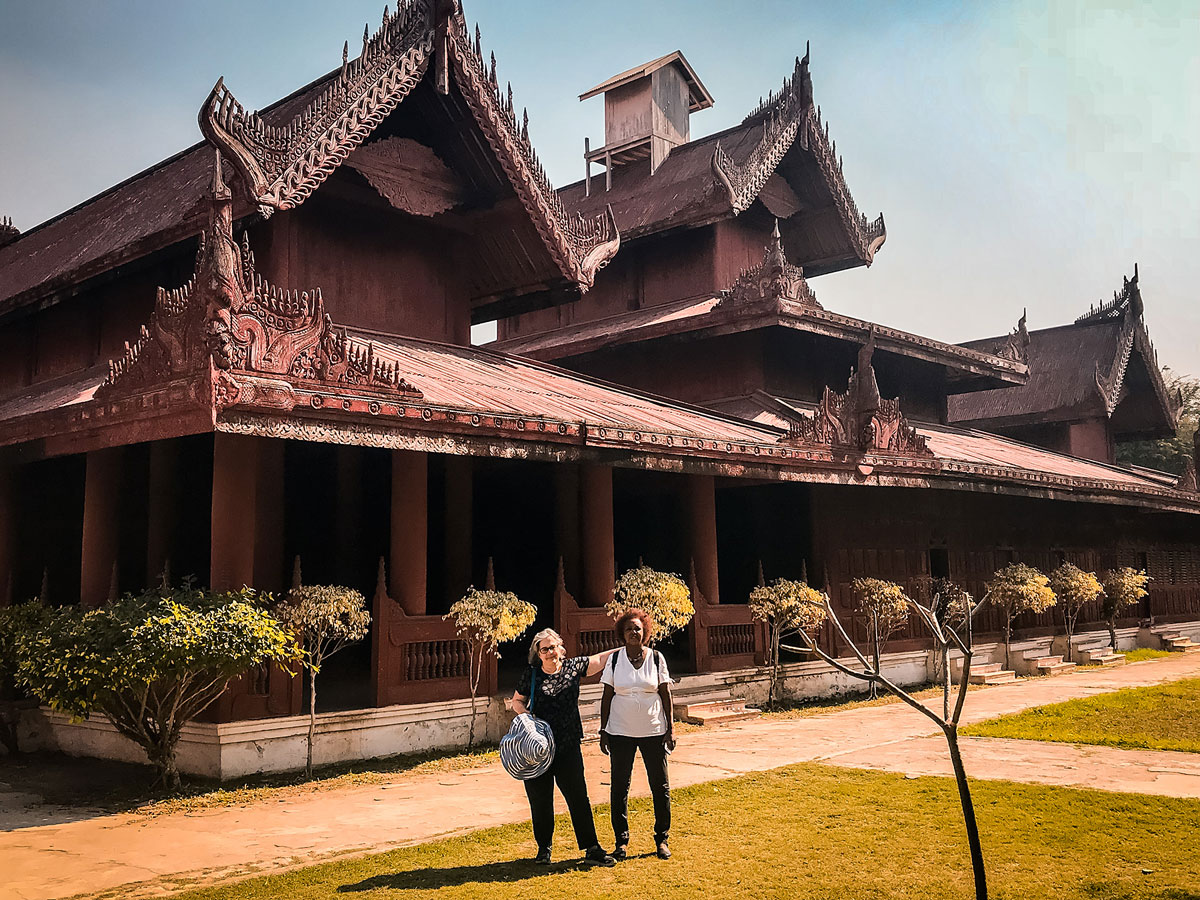
Also, amazing cravings are on the interior.

The visitors are not only foreigners, but locals.
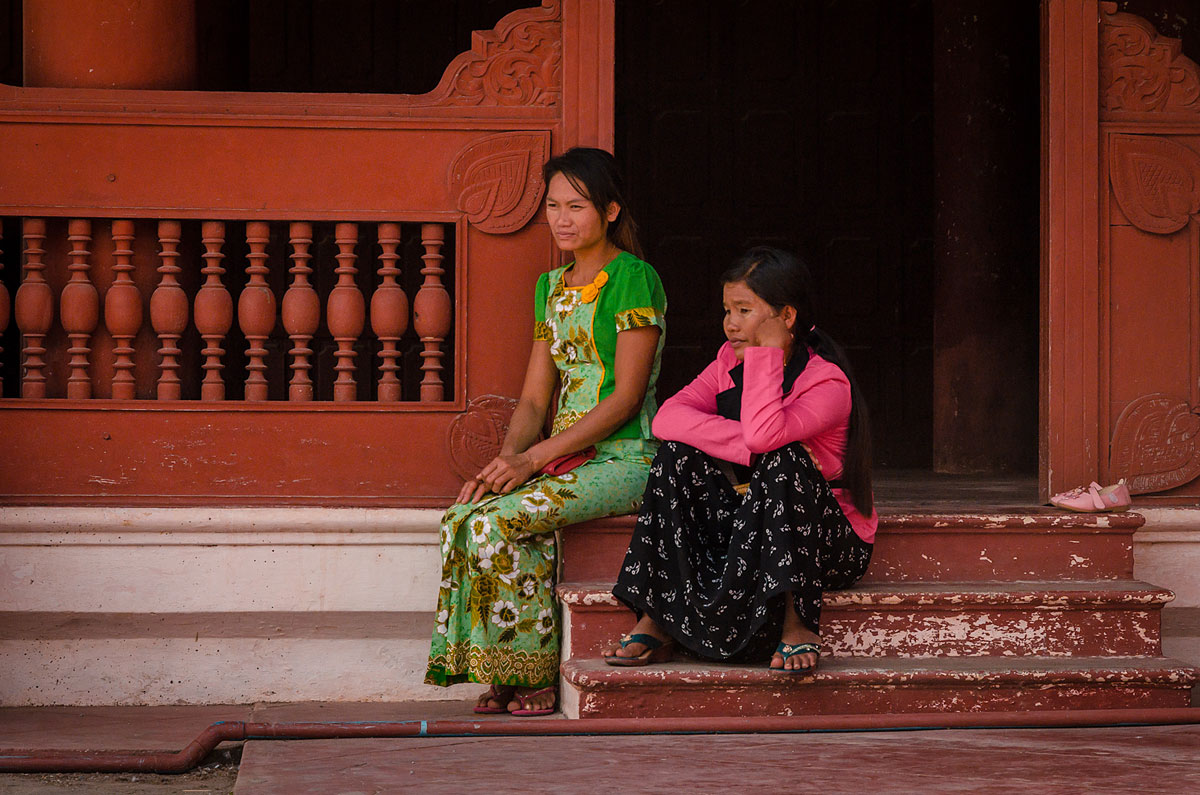
From the Observation Tower, we had a very good overview of the palace grounds and the city.

On the way down on the tower, we saw several young ladies pose on the steps.

In many of the rooms are museum quality items, from Buddha statues to furniture fit for a king. There were eight thrones in the Palace, of which the Lion Heads Throne (now in the National Museum in Yangon) was the most elaborately (see Part 1 of Myanmar posts).
Shwenandaw Kyaung Monastery
The Shwenandaw Kyaung Monastery is a stunning example of traditional teak monasteries from the 19th century. Just outside of the Mandalay Royal Palace, this monastery shares grounds with the Atumashi Monastery. This particular structure was originally part of the Royal Palace in Amarapura before the capital moved to Mandalay, where the Shwenandaw Monastery was deconstructed and rebuilt as a part of the Royal Palace in 1857. It is built with four tiers, one smaller than the other towards the top.
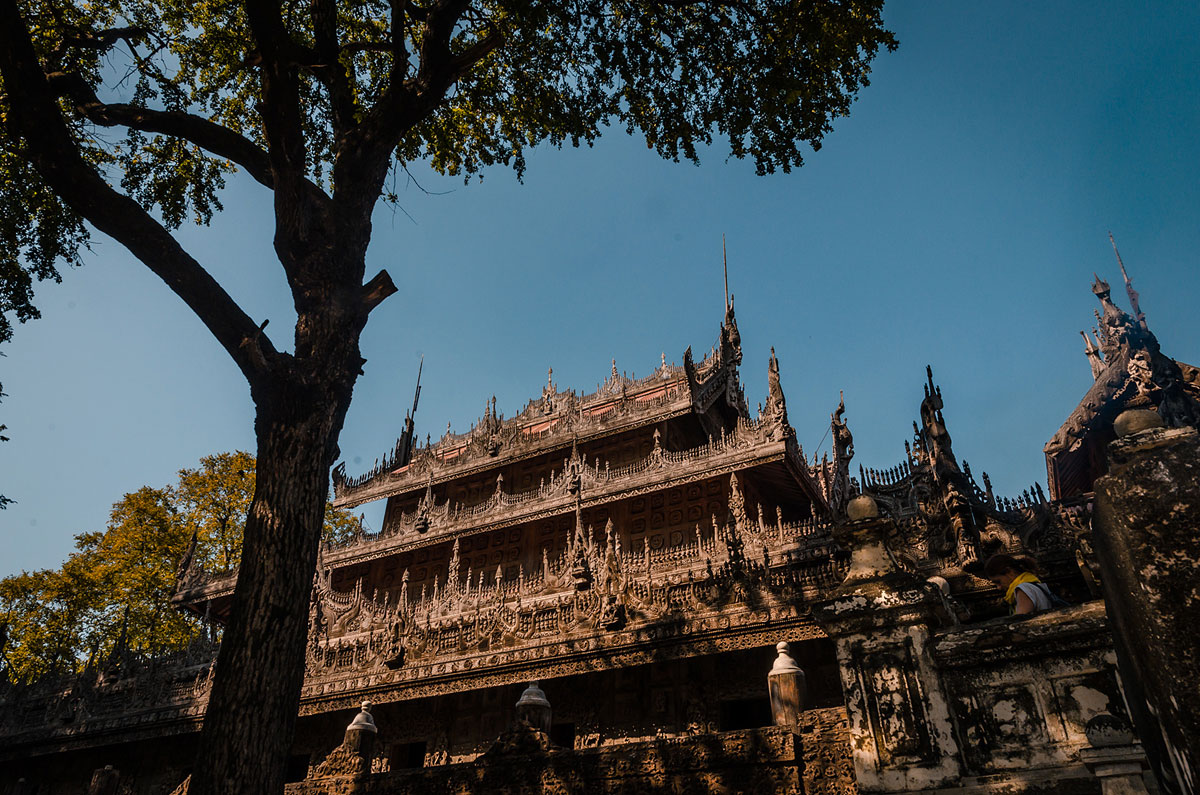
After the death of King Mindon who used the monastery as his personal living quarters, the monastery was moved to its current location and converted in 1880. This is the only major original teak building left of the Mandalay Royal Palace and has been well preserved. The intricacy of the wood carvings is exquisite.
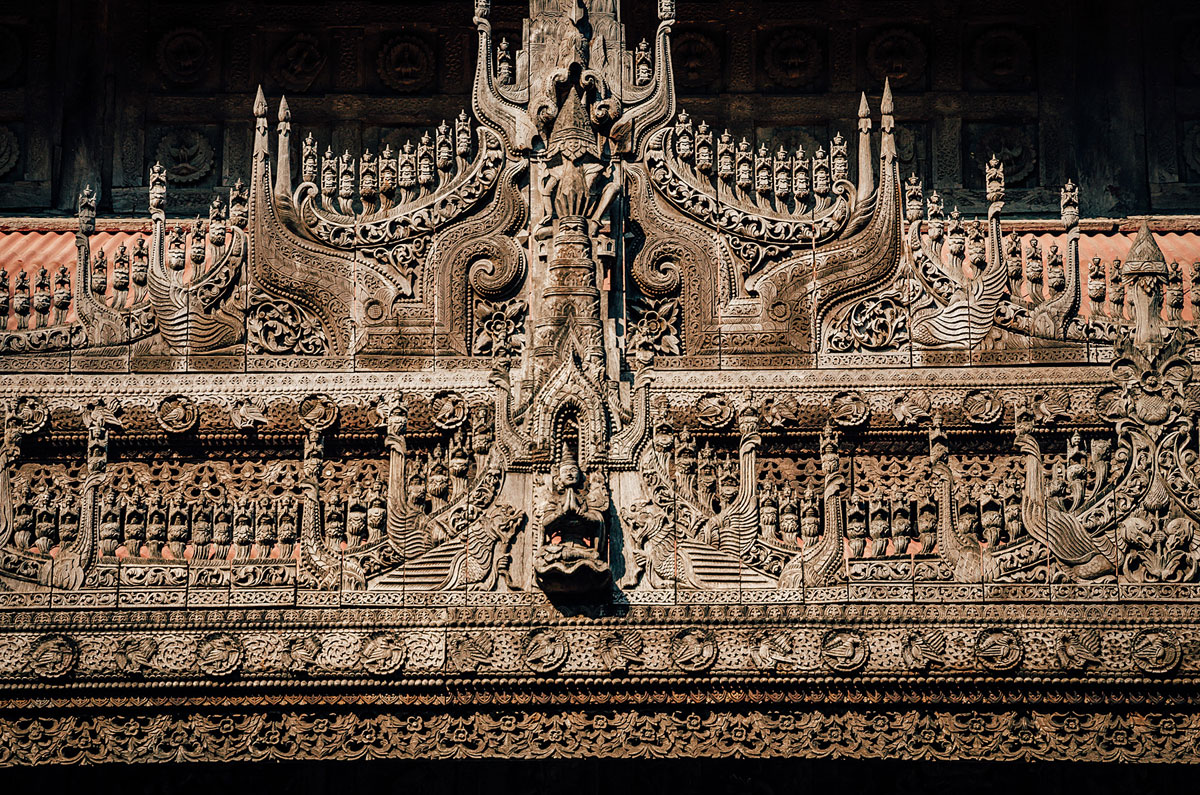
Caitlin commented upon the history and the architectural flourishes while standing out of the building.
There are rows of supernatural figures from the Jātaka tales (concerning the previous births of Gautama Buddha in both human and animal form), which Caitlin pointed out. One I liked was a demon next to a plant.
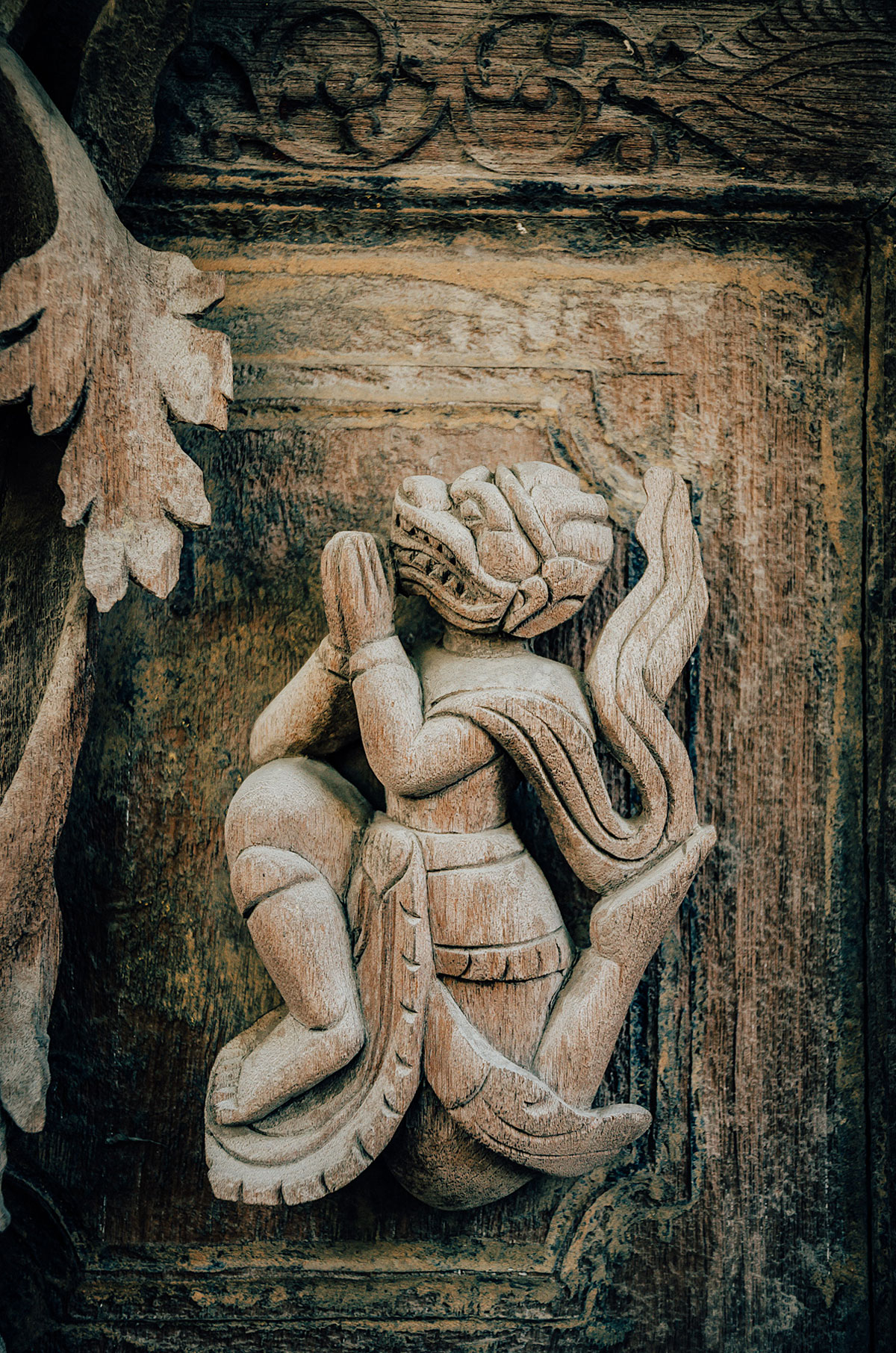
Another favorite was apparently a pregnant goddess.

On the way out, we saw these puppets for sale.
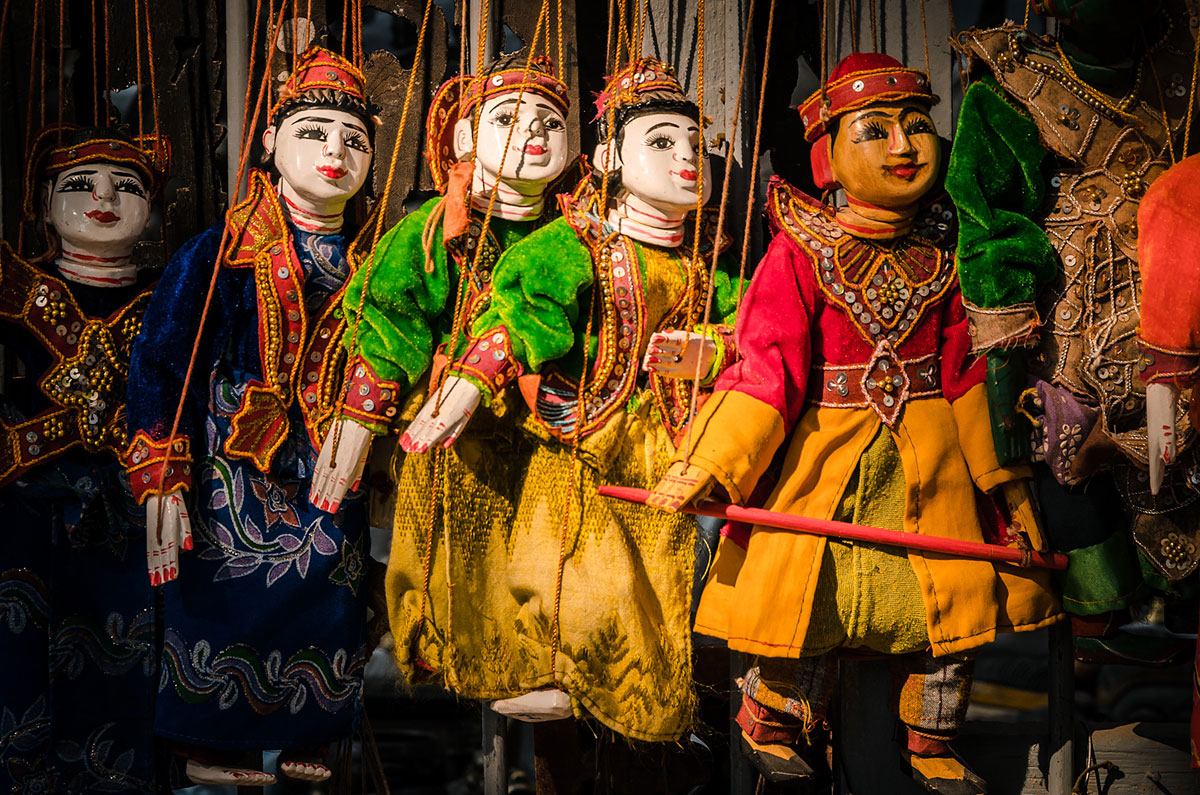
We used our archeological zone tickets for admission
Kuthodaw Pagoda
Commissioned by King Mindon, the Kuthodaw Pagoda was built as a part of the new Mandalay capital in 1859. The main entrance to the grounds is the South gate, a red gate decorated with depictions of animals and deities from Buddhist and Hindu mythology. From this spot, a long corridor leads to the main hall. At the center is a Buddha with neon lights radiating from around his head, a style that is frequently used in this country.

Around the pagoda is the “world’s largest book” enclosed in 729 white stupas.
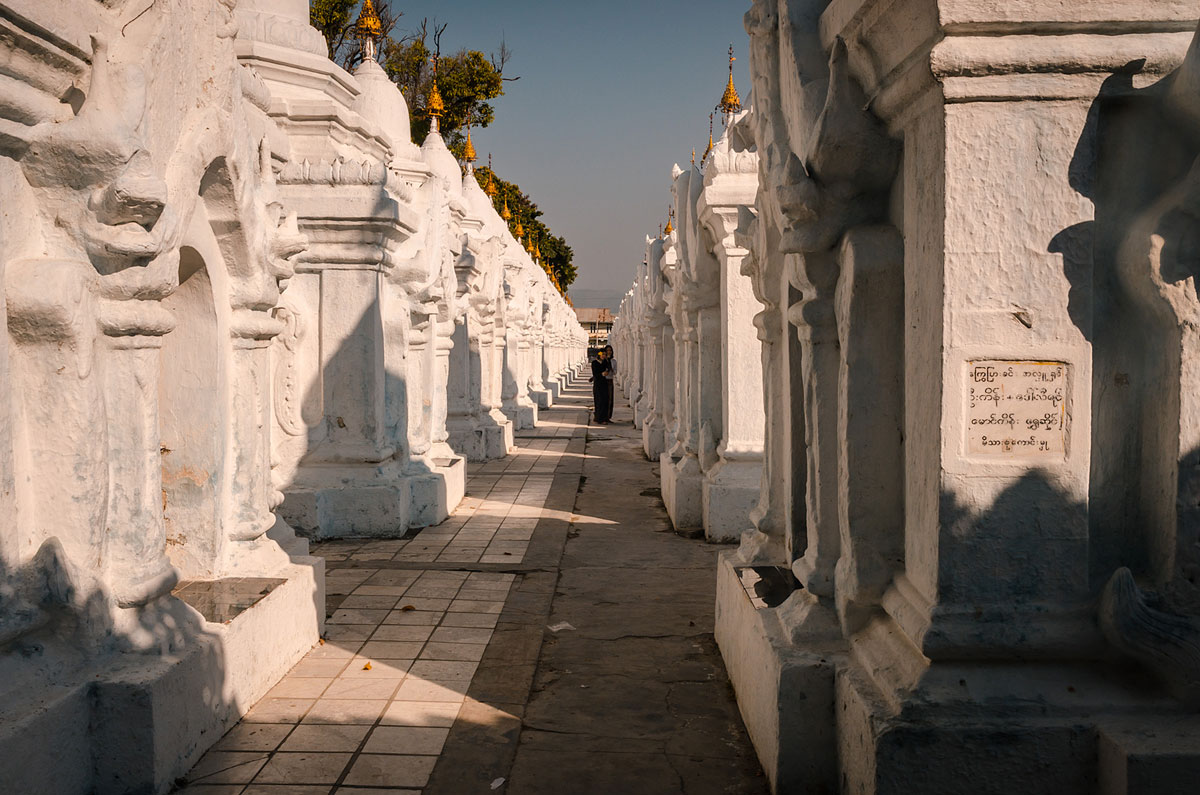
Each holds a slab inscribed with the Tripitaka, teachings of the Buddha, written in Ancient Pali.

Each slab represents one page of the book.
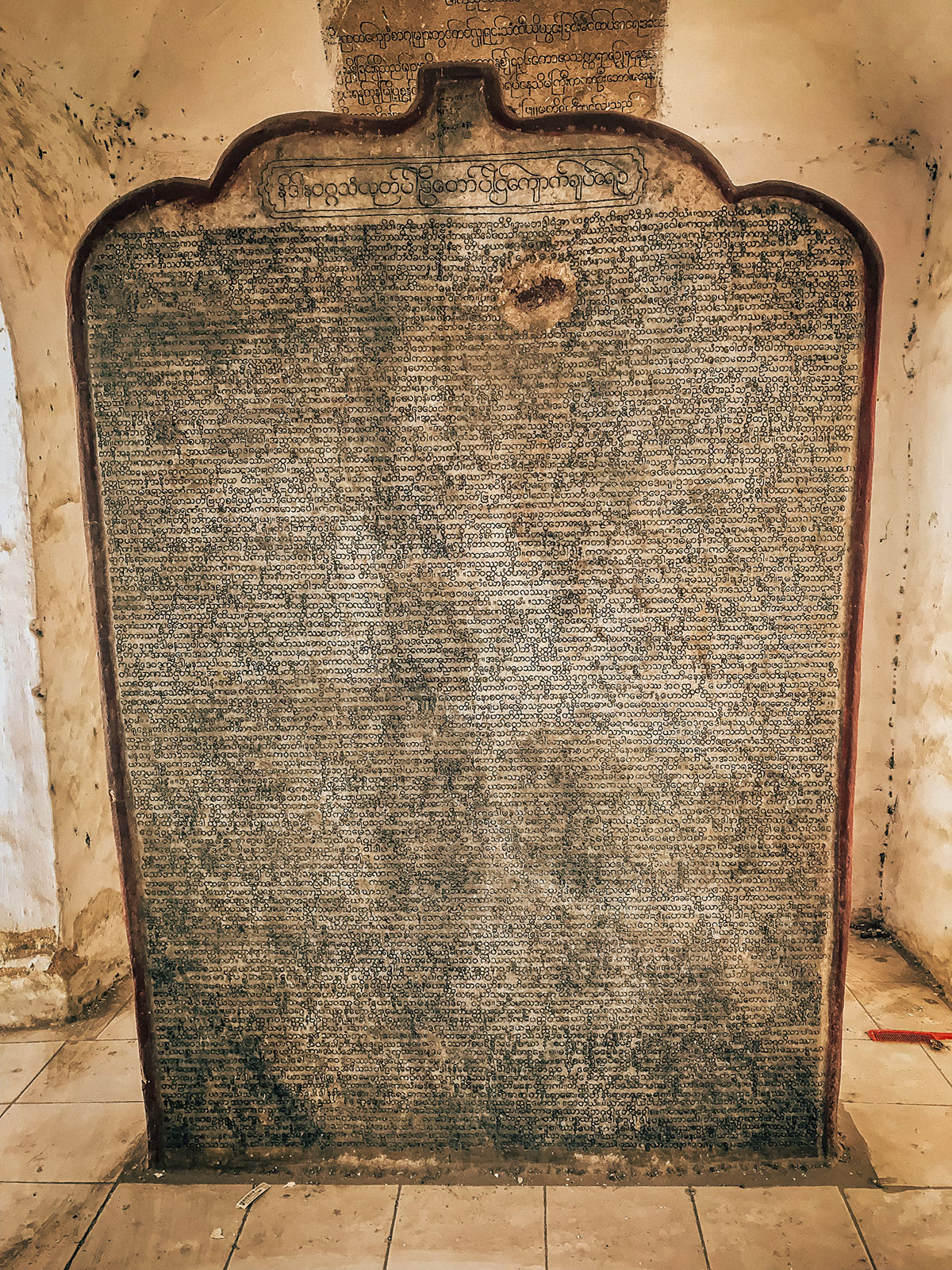
The last of the stupas holds the story of how the book came to be. Originally each line of writing was filled with gold ink and precious stones. During the British invasion in the 1880s, the grounds were used as a garrison and the temple site was looted and stripped of gold and gems. Today, the book has been refilled with a black ink after a decades-long restoration started after the British left.
We again used our archeological zone tickets for admission.
Mahamuni Temple
The Mahamuni Temple is one of the most famous and important sites of Buddhist pilgrimage in Myanmar. The complex includes the Mahamuni Museum, multiple shops, and the building holding the Mahamuni Buddha, a 3.8-meter-high image, is a gleaming statue covered in thick layers of gold leaf.
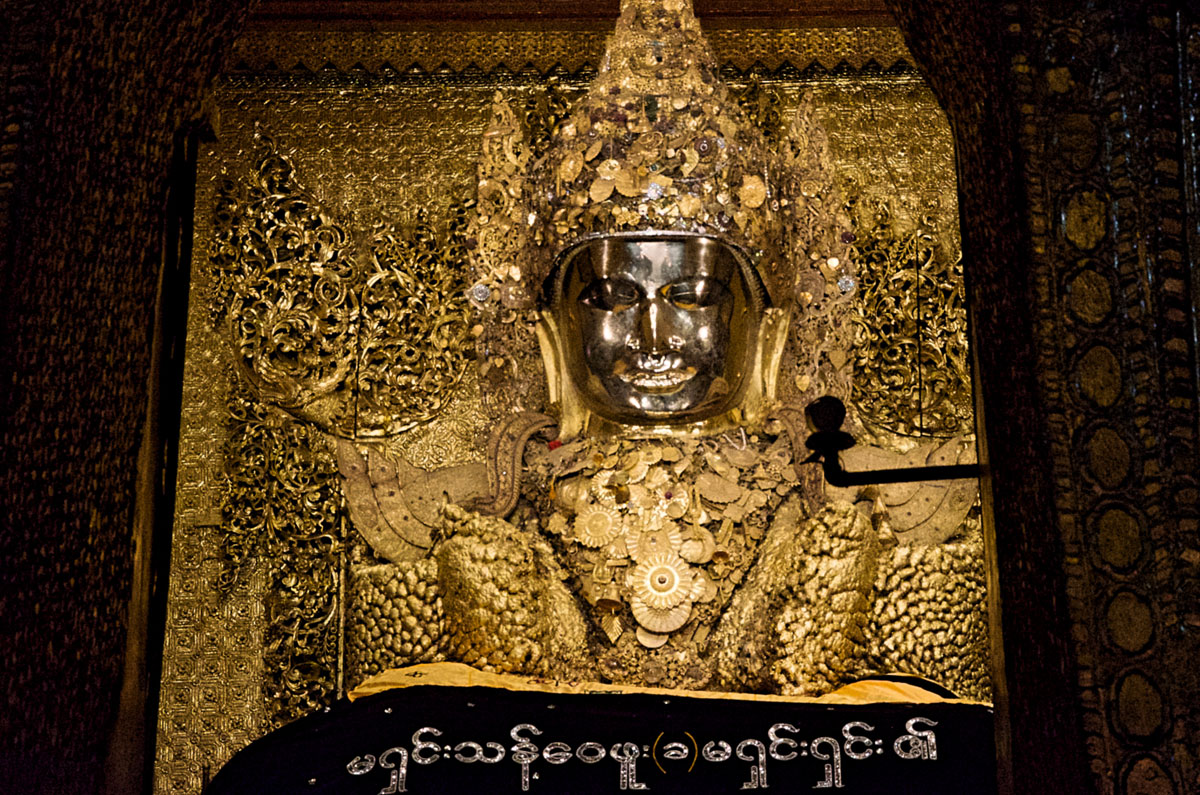
Male devotees (females not allowed) have placed and applied gold leaf again and again throughout the centuries. Over the years, the gold has become 15 centimeters (6 inches) thick and distorts the surface and detail of the image.
In the temple courtyard, there are many displays and items, such as bronze images from Angkor Wat in Cambodia during the 15th century. Another is a bell that can be rung for good fortune.
There was constant activity from tourists, worshippers and people working there, including these musicians.
Yet again we used our archeological zone tickets for admission.
Wood Craving
The city has many craft markets. The wood-carving areas have workshops lining the streets and are open for viewing. Wood-carving has been an integral part of the regional culture for centuries.

Most of the wood craving still uses traditional hand tools. The styles and methods have been passed down through generations.
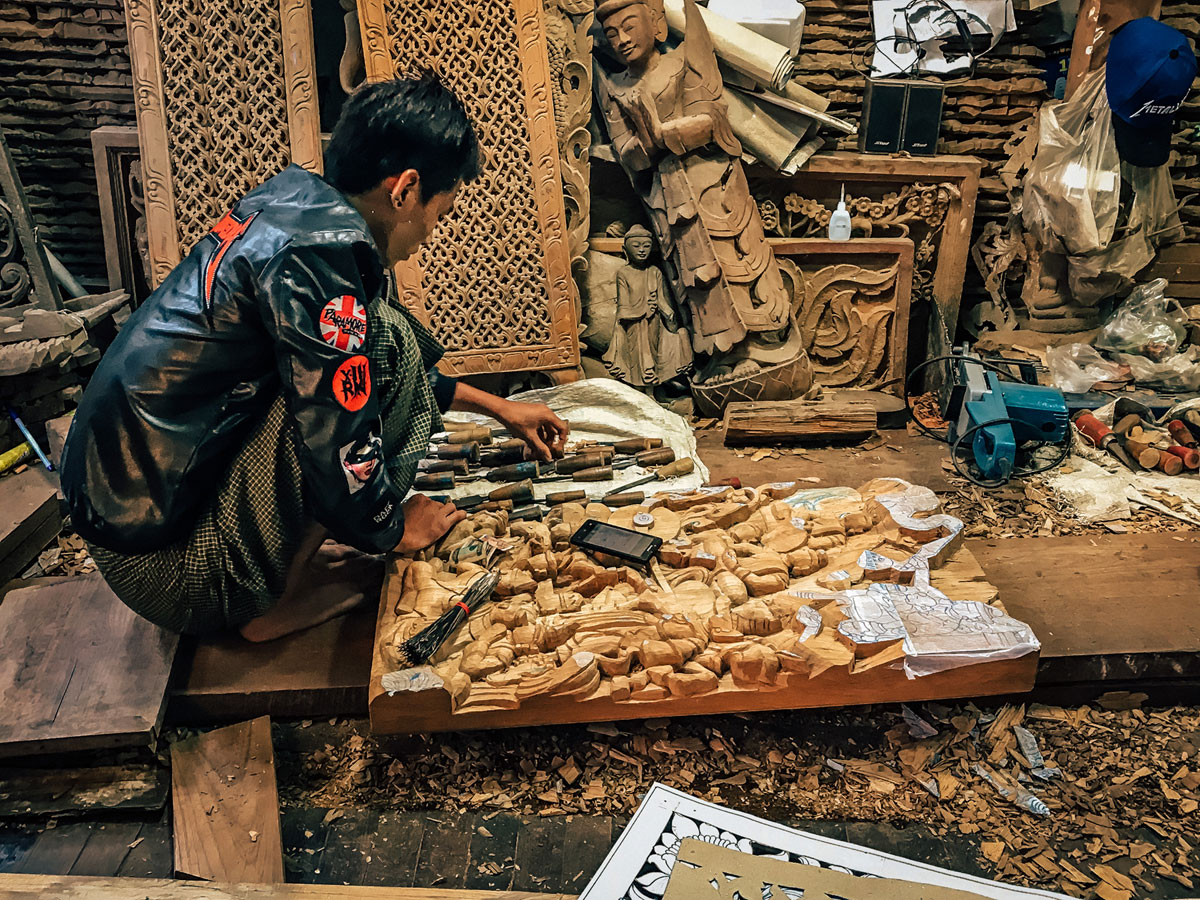
Around 36th street in Mandalay we saw numerous gold leaf workshops where the majority of gold leaf in in Myanmar comes from. Many of the workshops were in homes with signs outside indicating their business. The most interesting aspect of our short visit was watching the rhythm of gold-shaping. In fifteen-minute intervals, workers hammered ribbons of solid gold into thin pieces of leaf, then took a rest. These leaves were then packaged for sale or used to make small statues and jewelry. The items for sale were lovely, but pricy.
Mintha Theater
A highlight for us was the Mintha Theater. We went at 8:30pm for an hour-long performance of traditional dances from around Myanmar, all with lavish costumes in rich colored fabrics. The performers were students and faculty from Inwa School of the Performing Arts with live musicians.
We paid K14,000 (about $11.50) / person. In order to support this cultural and educational organization, we donated more after the performances.
Restaurants
We went to two restaurants for dinner while in Mandalay.
The four of us went the first night to MinGaLa Bar which had interesting curries, sweets, and snacks. Mingala is a standard greeting in Myanmar and means something like “it’s a blessing”. They were rated the No.1 restaurant in Mandalay on TripAdvisor in 2017. When we ate there, more than half of the diners were foreigners. The price was very reasonable, under $10 / person.
Our second night, Khadija and I went to Bistro@82nd, a European style restaurant in downtown Mandalay. We greatly enjoyed high quality appetizers and entrees, good drinks, attentive service and a pleasant atmosphere for about $50.
The real treat are small cafés and restaurants, with tasty food and warm service, such this one by Kuthodaw Pagoda where Peter, Caitlin, Khadija and I were chilling out.
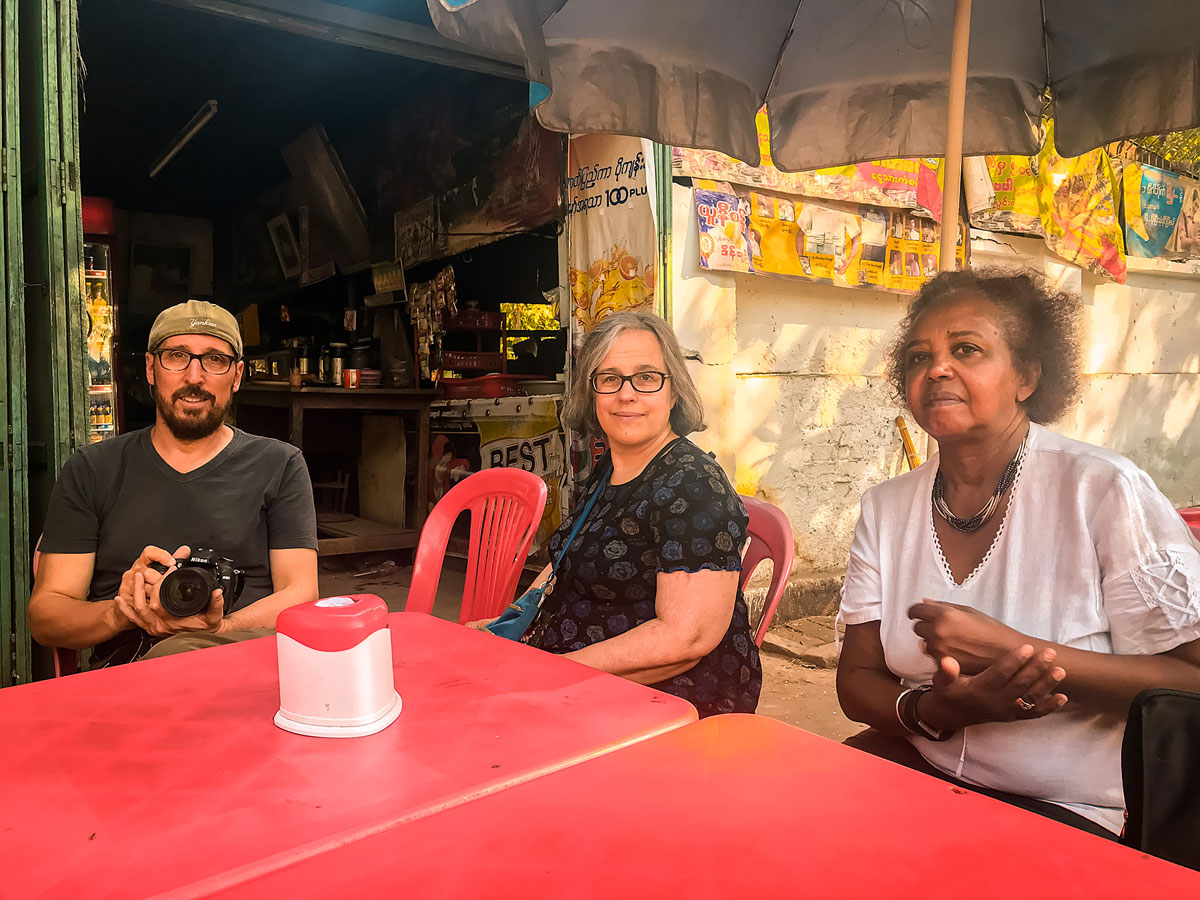
We were not the only ones there, but also a lone novice monk watching TV.
Sagaing Hill
On the drive to Bagan with a driver and a van, we stopped in two places, just outside Mandalay, which should not be missed.
From the center of Mandalay, through traffic, it took about 40 minutes for us to reach Sagaing. This is a provincial capital, though it seemed like a suburb of Mandalay. It was yet another ancient capital of Myanmar. We saw numerous stupas, pagodas and monasteries scattered throughout the forested hills. We visited the U Min Thonze Pagoda after walking up a steep, covered stairway laden with souvenir vendors. The most interesting site was the “Cave” with forty-three sitting Buddhas in a curved line.
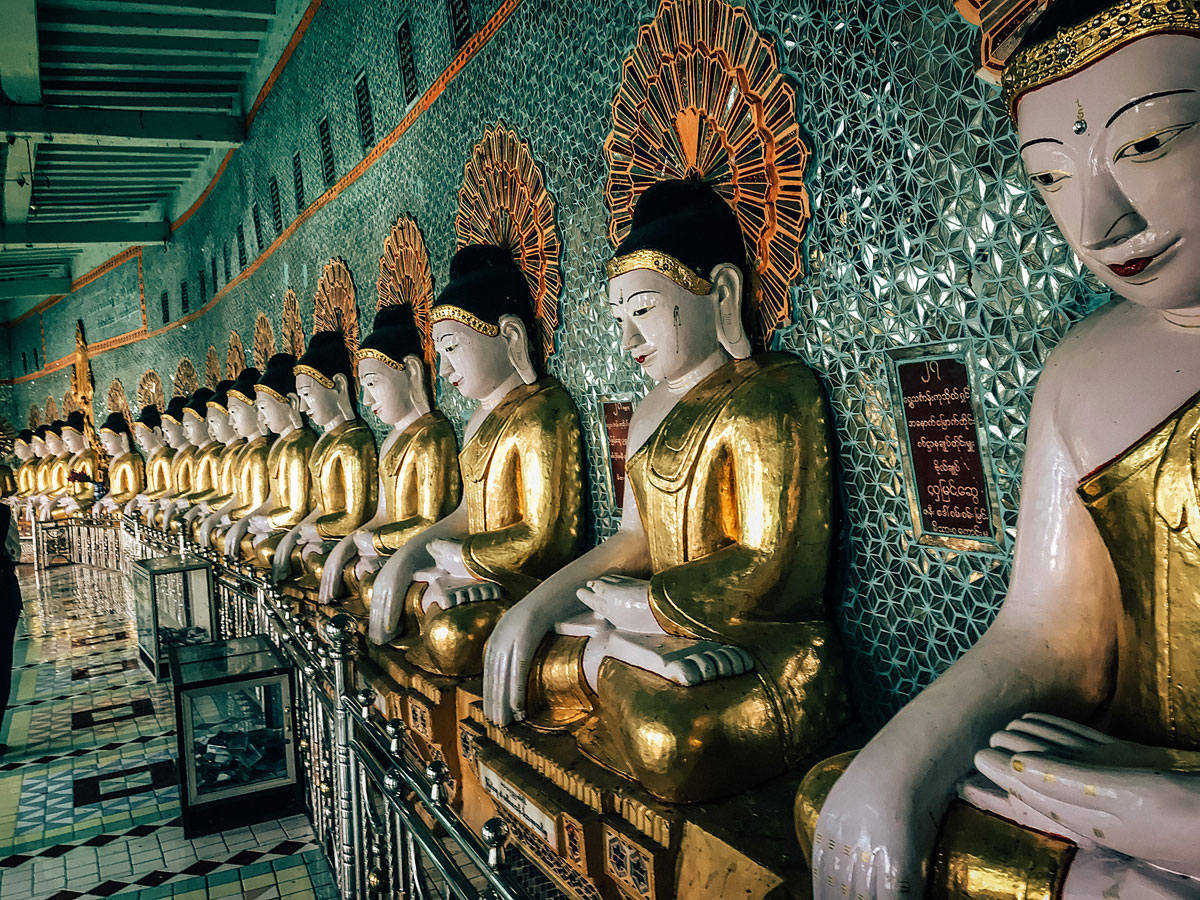
These Buddhas sat with serene expressions and golden robes, while two standing Buddhas guarded the doorways.
At the top of the complex, we saw the scenic panorama of the hills with stupas popping out of the forest cover.
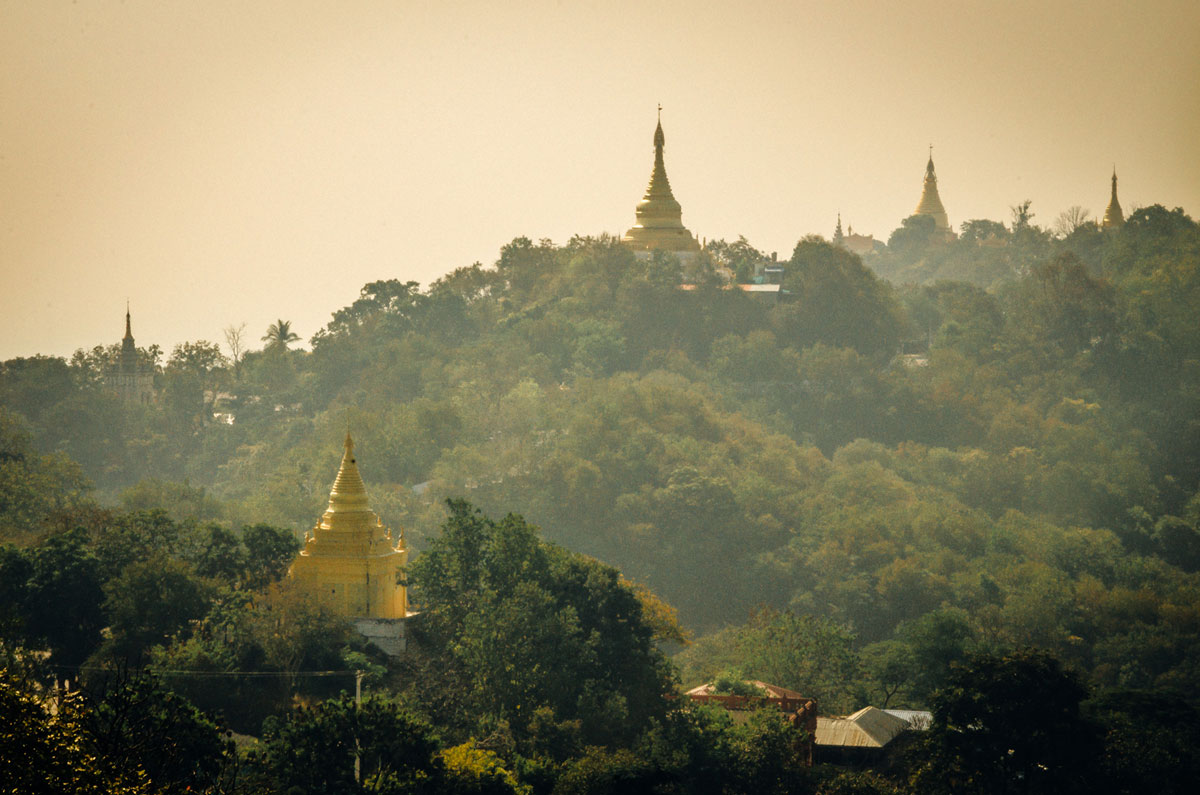
There are several monasteries and nunneries are in this area, home to 6,000 monks and nuns.
Hmwe Paya – Snake Temple
The small town of Paleik holds many temples in its lands, most abandoned and covered in foliage, but one in particular was very much alive. The Hmwe Paya or “Snake Temple” is famous for massive pythons living there. It is also a good photographic opportunity because of the serpentine residents and the locals who visit.
When we arrived at the steps of the temple, we saw a little girl holding her younger brother.
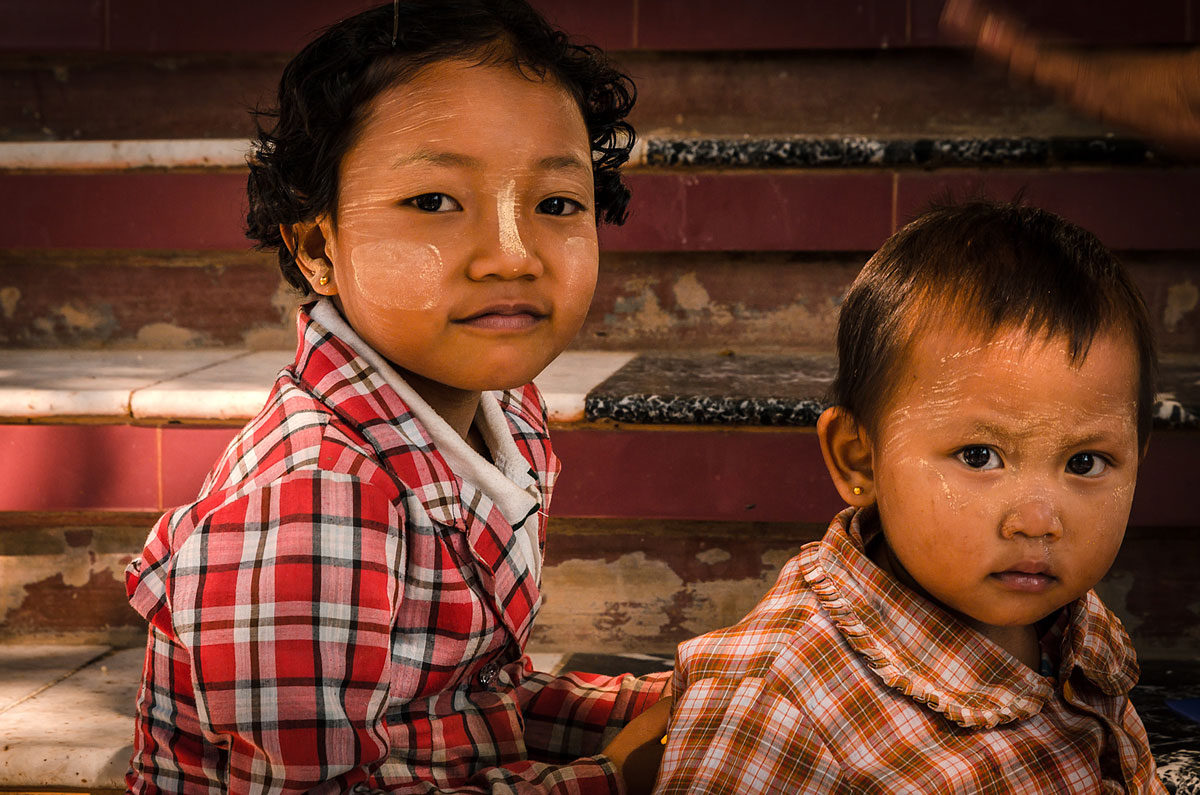
We arrived during the main activity of the day, the washing of the pythons at 11am. Caitlin and Peter were next to the bath observing the ritual.
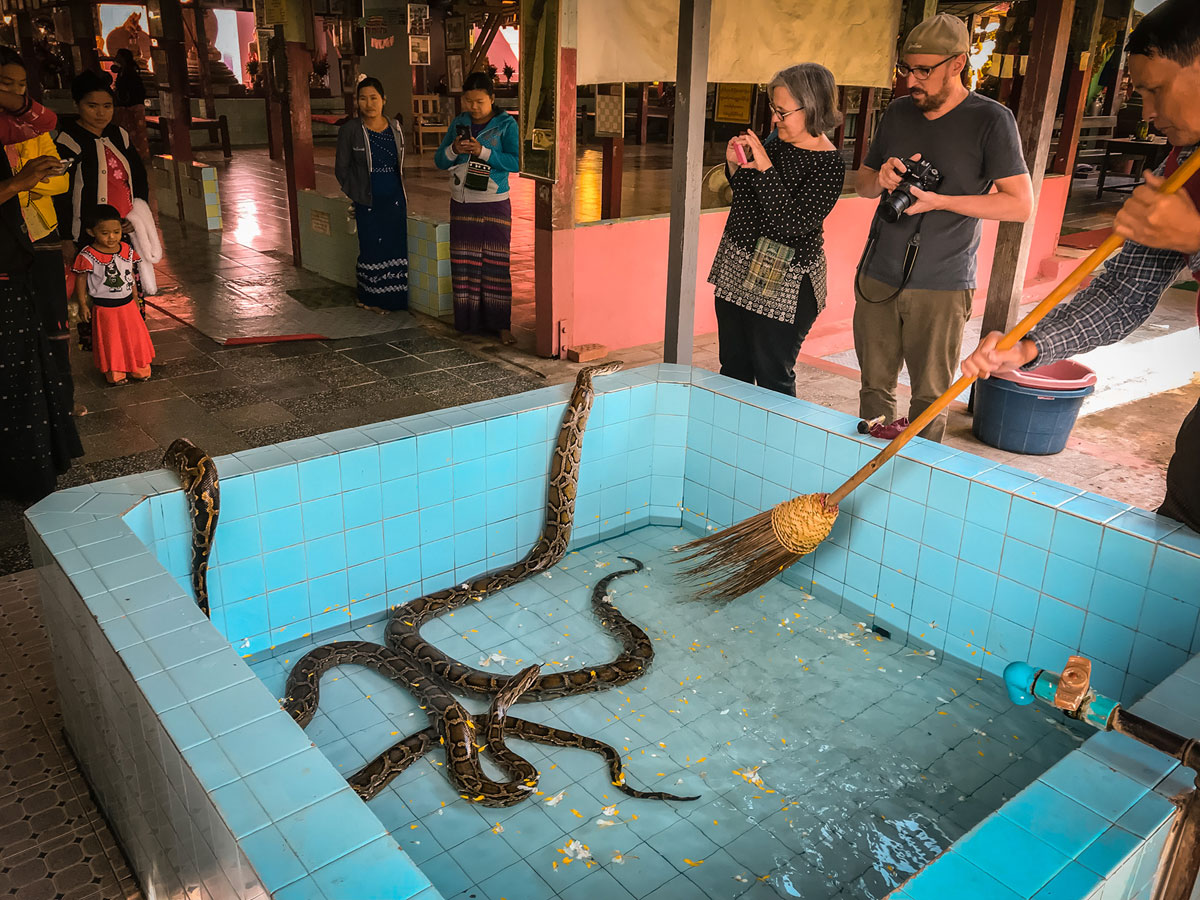
The pythons are considered holy to this town due to the temple’s peculiar history. In 1974, a Buddhist monk was tending the old pagoda where he found the statue of Buddha with two large pythons wrapped around it. The monk carried the snakes out and returned to do his duties only for the snakes to be back the next day. Each day, this would repeat until the monks and the town came to believe the pythons to be the reincarnated souls of the monks who used to tend the pagoda.
After the washing, for a few minutes, visitors were allowed to hold the snake, as I did.
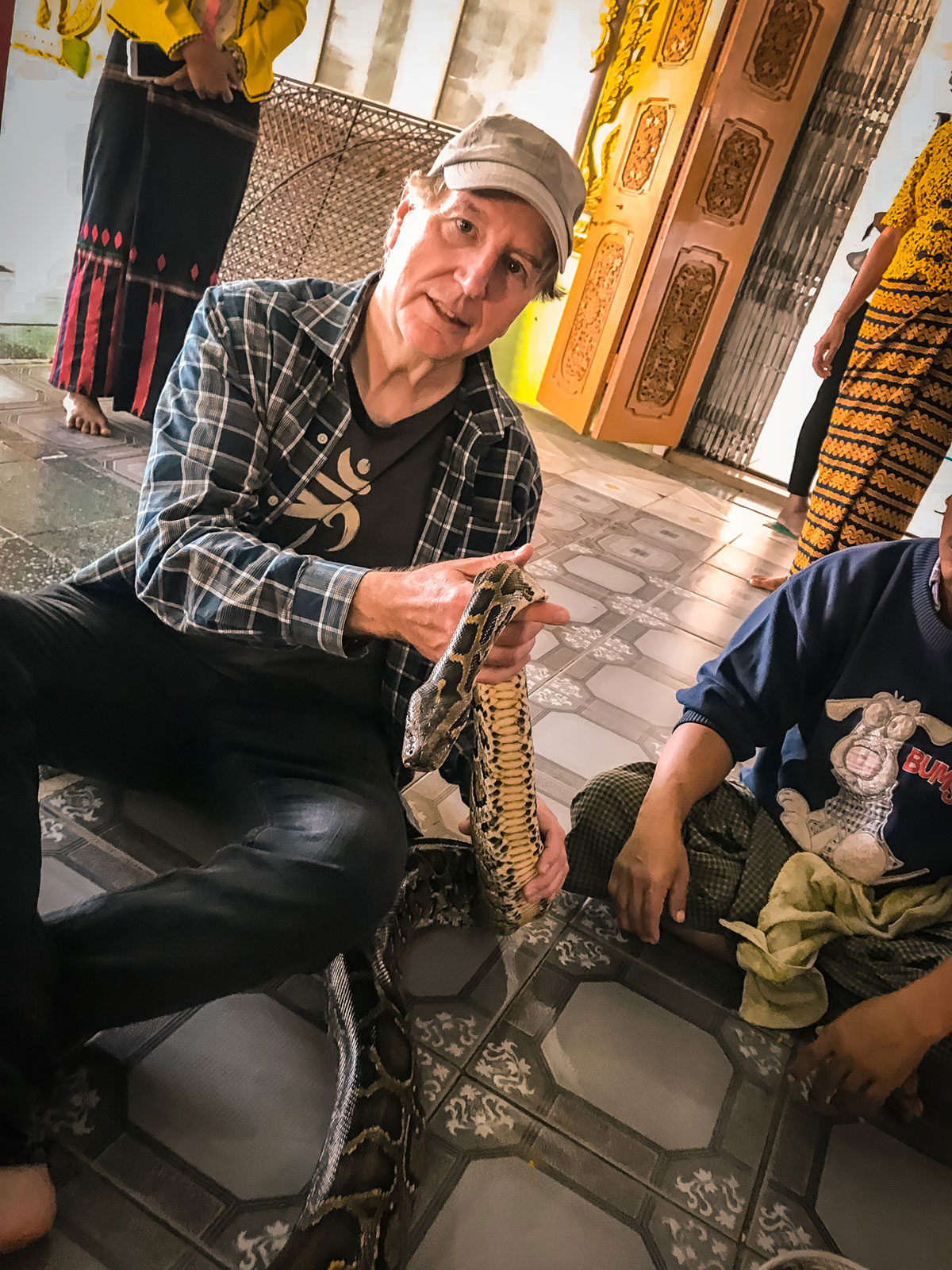
The snakes were taken to a statue of Buddha. In the pagoda, there were numerous statues of Buddha with a snake.
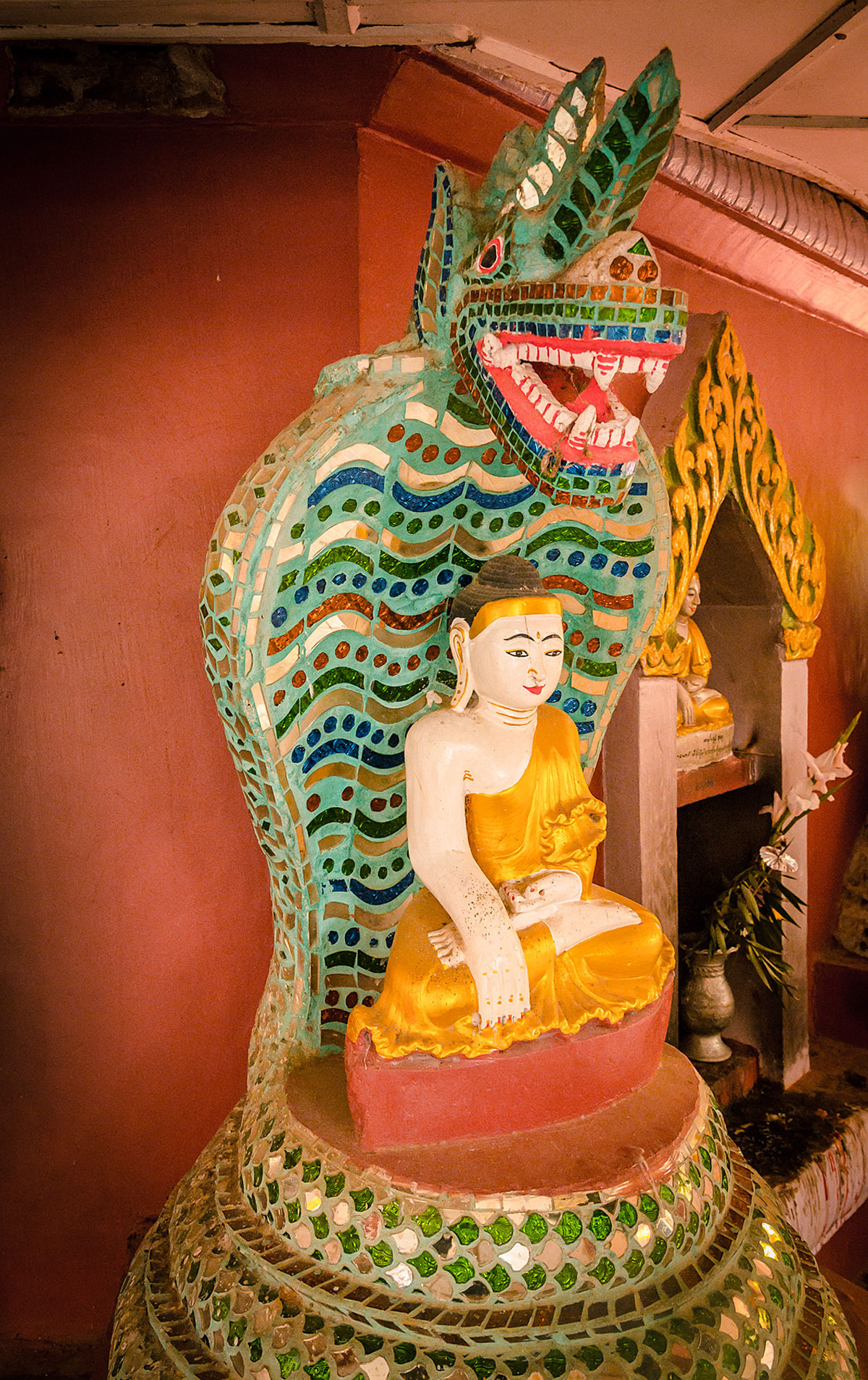
In the same hall as the snakes, there was a woman who showed us the application of thanaka, the yellowish-white cosmetic paste made from ground bark.
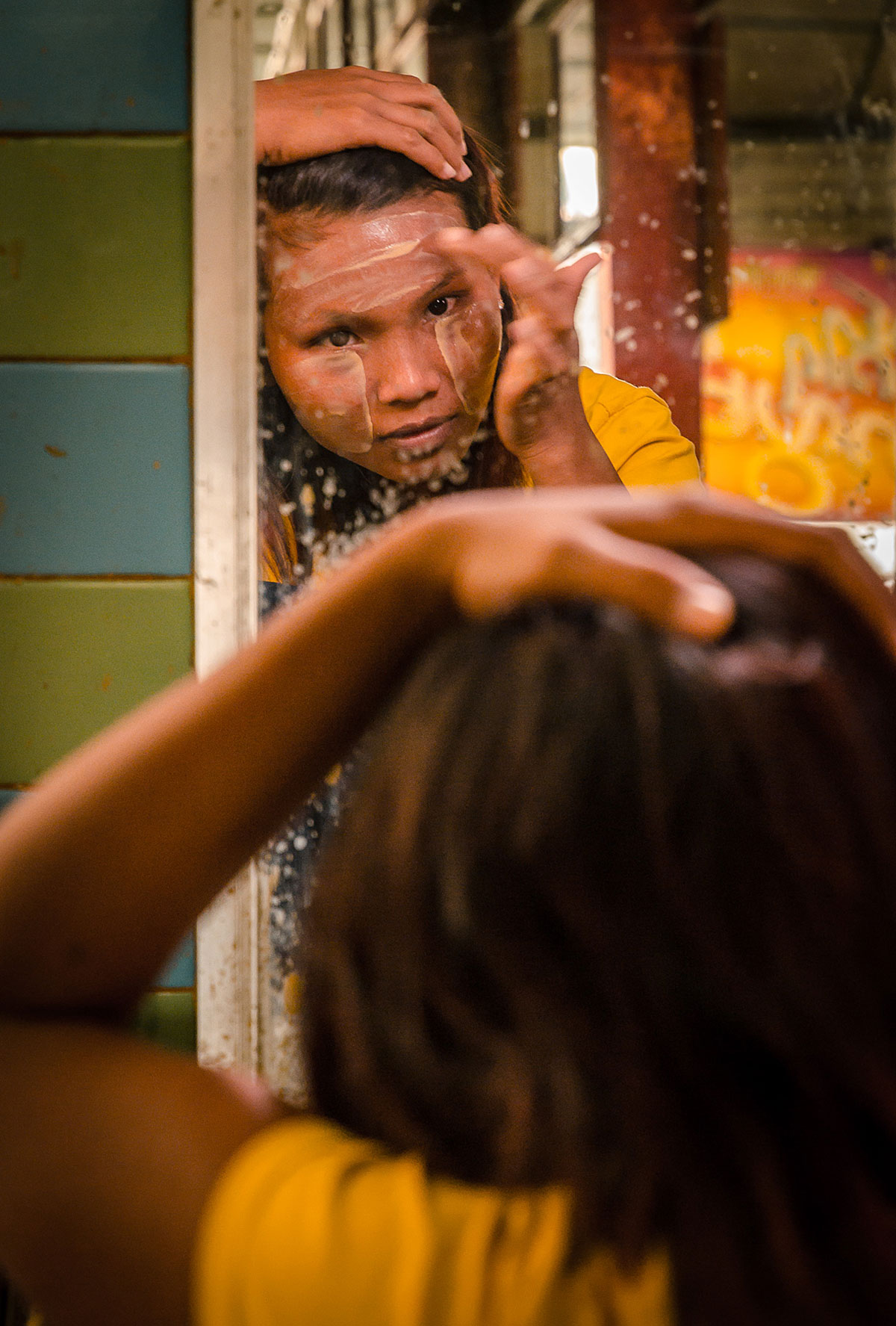
The final result for her and her child was the classic Myanmarese look.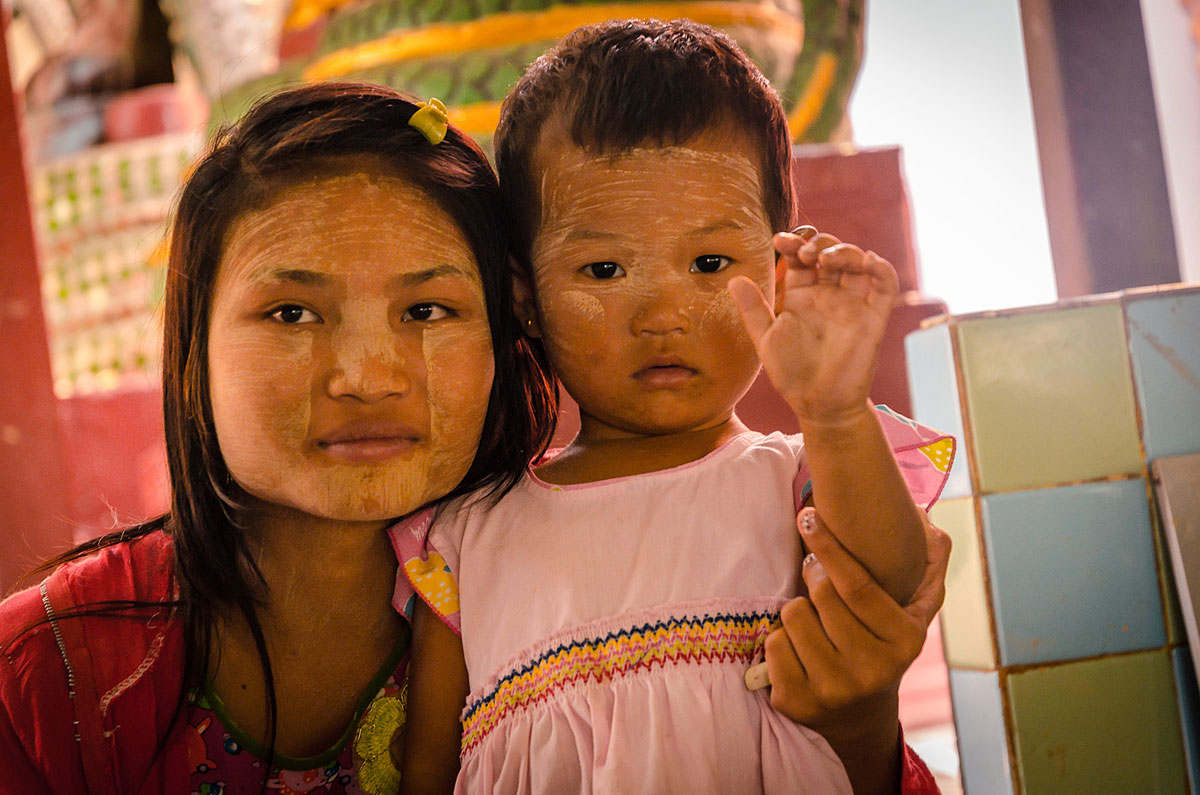
From here, we jumped into our van for our four-hour drive to Bagan. See Part 8, for the final Myanmar installment.

